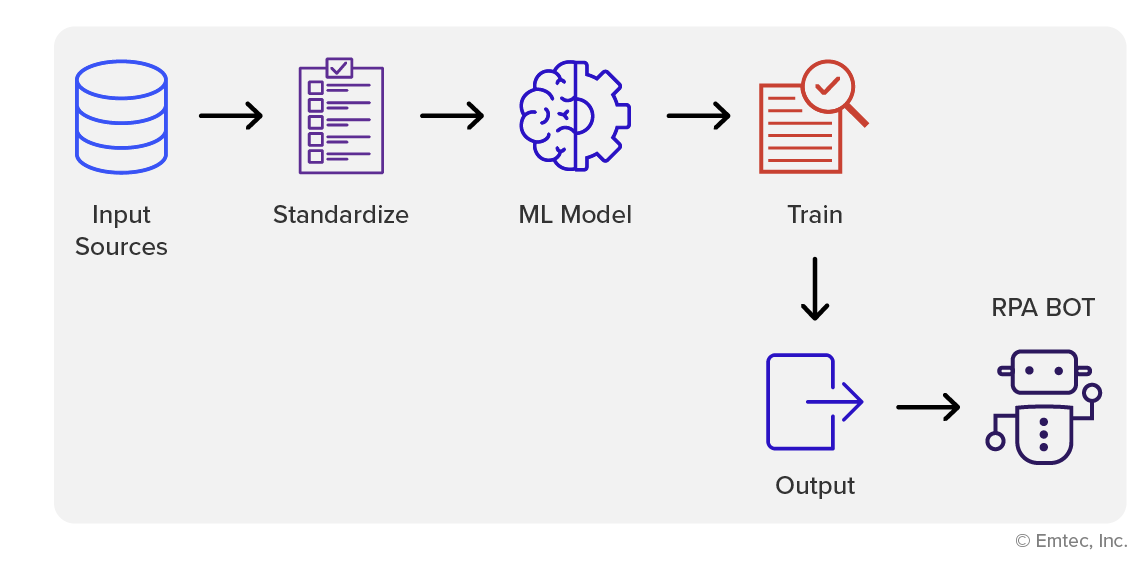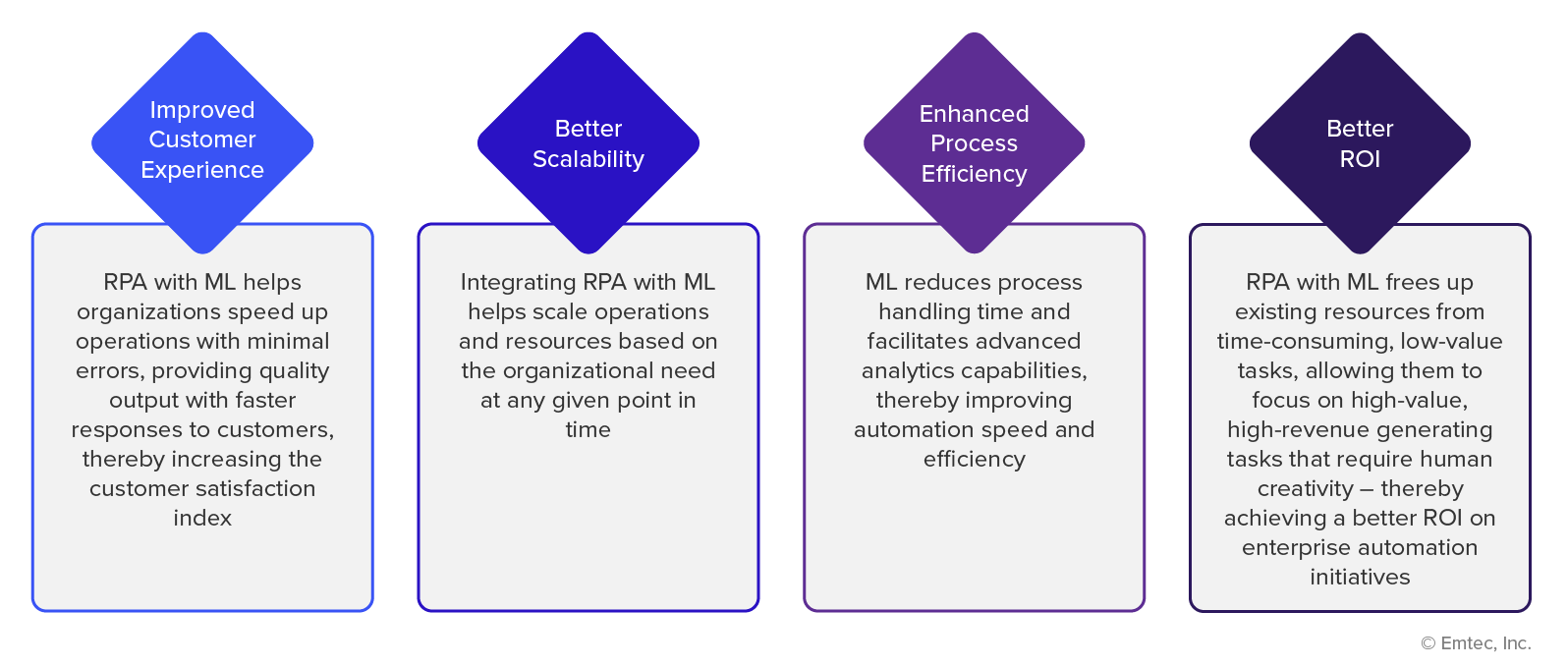Robotic Process Automation (RPA) is fast emerging as a key lever in fueling digital transformation. Enterprises are reaping the benefits of their RPA deployments in the form of increased productivity, reduced costs, and an increase in business profitability. A new report by Grand View Research forecasts the global RPA market to reach $25.56 billion by 20271, driven by organizational need to automate routine and repetitive business processes to reduce operational effort and time. With organizations now embracing RPA for scalability and resilience of critical enterprise processes, it’s time for the next big leap – turbocharging RPA with the power of Machine Learning (ML).
Challenges with the existing approach to RPA development
Businesses opt for automation to handle mundane or repetitive tasks so their employees can focus their time toward more critical or creative work. RPA bots interact with multiple systems including web-based applications, system applications, user portals, spreadsheets, databases, etc. to automate as-is business processes that are well defined, clerical, rule-based, and with structured input and output data. The bots then mimic human actions to complete those defined processes, which provides significant efficiencies as well as reduced human error. This conventional approach to RPA development, however, does have some limitations.
- RPA development is driven by predefined rules and lack of cognitive capabilities.
- RPA also requires structured data for processing, but most enterprise data such as credit letters, invoices, agreements, etc. is suppressed in an unstructured format.
- RPA bots require manual intervention for processing unstructured enterprise data owing to their inability to analyze, learn, and interpret information.
Here are a few real-life use cases that are, unfortunately, beyond traditional RPA capabilities:
- Reading image files with varying formats – RPA bots can read scanned invoices, but all invoices must be received in the same structured format with the exact same fields. Any variations in the format will affect the bots’ execution logic.
- Interpreting handwritten documents – RPA bots leverage only OCR to extract information from scanned handwritten documents. OCR can be quite inefficient when the document contains many elements such as lines and boxes. In these cases, OCR cannot detect the location of the text and will ignore or bypass it. Machine Learning (ML) based systems leverage character recognition algorithms including image pre-processing, feature extraction, and classification. Such a workflow prevents the system from missing and omitting important information, leading to more accurate extraction of relevant information from handwritten documents.
- Text or Sentiment Analysis – RPA automates simple rule-based tasks that often involve data processing and routing. However, RPA lacks capabilities to determine the context from unstructured data to get more useful insights. For example, it’s useful to know that a land deed mentions a company, a person and a bank. But it’s even more valuable to know that they refer to a “Lender” and a “Borrower” respectively. This problem can be solved by using Natural Language Processing (NLP) Machine Learning models. These models can be integrated into RPA to improve process efficiency.
Integrating ML models to improve process automation and create intelligent automation systems
Machine learning algorithms are trained over time to analyze data and parse relevant information from various data sources. This helps develop intelligent systems capable of taking decisions independently. But to achieve a high level of accuracy, merely building ML models is not enough – these models need to be regularly tuned and enhanced to deliver accurate results. Well-optimized ML models can then be integrated with various process automation tools to increase their processing capabilities.
Intelligent Process Automation framework using Machine Learning
Machine Learning components can be injected into RPA workflows to accomplish various tasks that are beyond traditional RPA capabilities. For example, image recognition, understanding document patterns, and analyzing voluminous data to interpret the correct output. ML components pull in enterprise data in a structured format and send it to RPA bots for further processing. ML does the thinking, understanding, and analysis while the RPA bots do the actual execution.

A few use cases of ML integration with RPA
-
Talent Acquisition: Recruiters receive thousands of applications for open positions. Shortlisting applicants based on pre-defined criteria is both challenging and very time consuming. This involves many steps including receiving and comparing applications to job requirement information to determine status and create a shortlist of qualified candidates. RPA can utilize the enterprise CRM application and other sources to shortlist candidates. However, leveraging only Robotic Process Automation Services, the bots can only process certain job requisitions with fixed resumes or application formats. It would be challenging to accommodate new position requirements, analyze the various types of resume formats, and extract all relevant details to make well-informed hiring decisions.
By integrating an ML component, the RPA bot would receive structured data in a pre-defined format to process and shortlist applicants. The ML component would receive resumes in varying formats, then normalize the resume content and exclude variations to put the resume data into a standard format before it begins data extraction. The ML component determines the relevant resume data based on specific keywords, headers and keys. Later, it calculates the resume’s confidence score based on the data extracted and releases it to the RPA bot for further processing in the CRM. The RPA bot then captures the confidence score for each candidate profile and based on the confidence value, updates the application status in the CRM.
-
Invoice Processing: Multiple suppliers send out scanned invoices over email to accounting departments for processing in their ERP application. Accountants manually process these invoices by reading the data on the invoice and entering it into the ERP application. Different suppliers follow different invoice types and formats (scanned PDFs, images, or handwritten documents). Further, some documents may be poorly scanned – blurred, lack contrast, have incorrect alignment or span multiple pages. This could be challenging in an “RPA only” approach, where the system workflows are developed for all documents with fixed formats. To overcome these limitations, ML models can be introduced to extract the relevant details from various types of documents. The ML component along with the OCR engine carries out image pre-processing to adjust incorrect alignment, improve brightness and contrast to remove dirt, and sharpen the images to improve their quality before processing. Most of the invoices are generated in tabular formats. ML leverages the table extraction logic to convert tables from the invoices into an editable format that is later added to flat files. This extracted data will be consumed by the RPA bots for processing into their ERP systems.
-
Customer Support Request Processing: In insurance companies, customers use the support portal to resolve concerns, find suitable insurance policies that meet their needs, and review the performance of their portfolios. Conversational bots powered by AI can simulate interactions with a customer service representative to train them how to resolve simple inquiries to offer an effective self-service solution. This improves the turnaround time to resolve customer grievances quickly and enhances operational efficiencies, leading to high customer satisfaction levels.
Key benefits of Machine Learning in enterprise process automation
The combination of RPA and ML has great potential! RPA provides tangible benefits such as faster and agile enterprise processes, reduced compliance costs, and low risk. Bots have access to tons of enterprise data – if they can be programmed to segregate useful information, Machine Learning can leverage this to accurately train data forecasting models.
Some of the top benefits of incorporating an RPA + ML strategy are outlined below.

At Bridgenext (former Emtec Digital), we help organizations successfully integrate RPA and ML to increase operational efficiency and reduce costs. Contact us today to learn how you can boost your enterprise process automation capabilities with the power of Machine Learning.
References
https://www.grandviewresearch.com/press-release/global-robotic-process-automation-rpa-market


